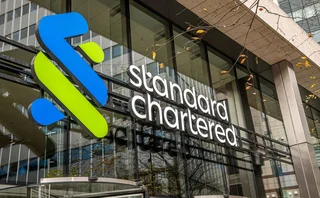

TLAC buffers up at all but three systemic US banks
BNY Mellon, Citi and Wells Fargo saw their headroom shrink from a year ago
The total loss-absorbing capacity (TLAC) of the largest US banks increased over the past 12 months, despite BNY Mellon, Citi and Wells Fargo bucking the trend.
Risk Quantum analysis of the eight systemic US banks saw the average ratio of TLAC-eligible debt and equity to risk-weighted assets (RWAs) across the group was 31.2% at end-September, up from 30.8% a year earlier.
The average minimum requirement over the period fell slightly, from 21.1% to 20.9%.
Three banks saw their TLAC buffer shrink from the third quarter of 2020. Wells Fargo posted the largest reduction, with a drop of 208 basis points to 23.7%. BNY Mellon followed suit with a 50bp reduction, to 27.3%, ahead of Citi’s 40bp drop, to 24.8%.
On the flip side, Goldman Sachs reported the highest increase, as its RWA-based TLAC ratio increased by 240bp to 42.2%.
Morgan Stanley continues to have the greatest amount of headroom above its minimum, with its TLAC ratio a whopping 31.6% above its 18% requirement.
Goldman Sachs has the second-largest buffer on top of its minimum requirement, at 20.7%.
In contrast, Citi and Wells Fargo have thin buffers on top of their requirements, just 230bp and 218bp, respectively.
What is it?
TLAC, a concept designed by the Financial Stability Board and finalised in November 2015, is intended to prevent taxpayer bailouts of imploding systemic banks by forcing them to maintain a fixed ratio of debt and capital to risk-weighted assets and exposures.
As of 2019, designated G-Sibs have been obliged to hold minimum TLAC worth at least 16% of RWAs and 6% of leverage exposure. In 2022, the minimums jump to 18% and 6.75%, respectively.
On top of this, systemic lenders must also hold enough to meet additional regulatory capital buffers, such as the G-Sib, capital conservation and countercyclical add-ons. European Union banks are also subject to additional bail-in bond requirements under the minimum requirements for eligible liabilities regime.
Why it matters
Regulators have tied the amount of capital a bank can give back to shareholders and in bonus payments to executives to a minimum TLAC requirement. Firms are incentivised to issue debt in order to stay above it. Failing to do so will restrict their ability to pay dividends, a position no dealer wants to find itself in.
Moreover, TLAC requirements ebb and flow to deter systemic banks from growing too big. If their size increases, so do their TLAC minimums. More debt is then needed to cover the gap, in an endless loop.
Some banks seem to have taken this more seriously than others. The fact Morgan Stanley has a headroom of almost 32% above its requirement is testament to the work management has done through the years to build a strong buffer.
For those dealers that saw their buffers shrink, there are only a handful of options on the table: issue more bail-in bonds to top up their ratios over the coming months, cut dividend payouts, or curb their balance sheets.
Get in touch
Like Risk Quantum? Sign up for free to our daily newsletter and check @RiskQuantum for the latest updates.
If you have any thoughts on our latest analysis or want to suggest other ways to present and analyse the data, you can email us.
Tell me more
Only users who have a paid subscription or are part of a corporate subscription are able to print or copy content.
To access these options, along with all other subscription benefits, please contact info@risk.net or view our subscription options here: http://subscriptions.risk.net/subscribe
You are currently unable to print this content. Please contact info@risk.net to find out more.
You are currently unable to copy this content. Please contact info@risk.net to find out more.
Copyright Infopro Digital Limited. All rights reserved.
As outlined in our terms and conditions, https://www.infopro-digital.com/terms-and-conditions/subscriptions/ (point 2.4), printing is limited to a single copy.
If you would like to purchase additional rights please email info@risk.net
Copyright Infopro Digital Limited. All rights reserved.
You may share this content using our article tools. As outlined in our terms and conditions, https://www.infopro-digital.com/terms-and-conditions/subscriptions/ (clause 2.4), an Authorised User may only make one copy of the materials for their own personal use. You must also comply with the restrictions in clause 2.5.
If you would like to purchase additional rights please email info@risk.net
More on Risk Quantum
Commerzbank wager swells UniCredit’s modelled RWAs by 62.5%
Total return swaps on German shares inflate VAR and SVAR components
Consolidation of Arval exposures adds €20bn to BNP Paribas’ RWAs
Bank shifts exposures from soon-to-be retired equity IRB treatment to standardised approach
Russian loan liquidation lifts RBI’s risk density
Cash parked at sanctioned central bank carries higher capital requirements than original loans
CCPs’ skin in the game drops to historic low
Clearing members bear increasing load, analysis of 15 clearing houses shows
StanChart’s market RWAs hit eight-year high
Client-driven RWA deployment raises market risk exposure by $3.2 billion
Valley National sees surge in delinquent CRE loans in Q3
Bank’s net charge-off rate more than doubles as $114 million in CRE loans become past due
UBS logs three VAR breaches on legacy Credit Suisse positions
Bank risks higher capital charges amid market volatility and exit-related costs
HSBC’s China CRE provisions surge to cover one-fourth of book
Additional reserves and reduced exposure elevate ECL coverage for mainland portfolio








